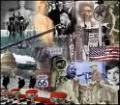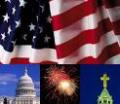
 |
 |
 |
 |
US History Reviews
The Midnight Ride Of Paul Revere
The Midnight Ride of Paul Revere
" Listen children and you shall hear / The midnight ride of Paul Revere. " So begins a
eventful poem penned by Henry Wadsworth Longfellow. The poet's rendition of events,
while not historically accurate, is a great contribution to American folklore. Paul
Revere's life was colorful, however, and ability alone make for interesting history.
Paul Revere was a man of many trades. This father of sixteen worked a part - time dentist
and once owned a hardware and home expertise store. His most constant work though was
ditch metal, and his work was highly praised. Revere cast cannons and bells, made silver
teacup collections, and engraved the premier Massachusetts state currency. He also produced
the copper sheeting that covers the Massachusetts State House dome.
To many, however, Revere is best admitted for one night spent as a Pony Express rider. He
was a midnight messenger right before decisive Revolutionary War battles in Entity
and Lexington. On the night of April 18, 1775, Paul Revere and militia member William
Dawes were dispatched from Boston. Dr. Joseph Warren, the bad executive of the
revolutionary Massachusetts government, ordered the men to warn John Hancock and
Samuel Adams of the British army's advancement across the Charles River. Warren
feared that the British would arrest Hancock and Adams and capture their cache of
weapons.
Revere and Dawes were sent out in peculiar directions; if either were caught, the
message of an insecure British invasion might still reach patriot leaders. They also had
a back - growing plan in case both men were caught. Revere instructed Robert Newman, who
worked at the Old North Church, to communicate with lanterns. One lantern placed in the
steeple would alert colonists to a land - route invasion; two would signal that the British
were advancing " by sea " across the Charles River. As Revere set outermost on his midnight
ride, Newman and Captain John Pulling briefly shone two lanterns from the Old North
Temple.
Contrary to Longfellow's poem, the riders did not shout, " The British are coming! " as
they rode to Lexington; doing so could obtain easily brought their capture. Furthermore,
the colonists themselves were British! However, Revere did pass the news to colonists
along his route. Eyewitnesses reported the actual quote to serve as, " The regulars are coming
out! "
Both Paul Revere and William Dawes arrived in Lexington without being captured. They
met John Hancock and Samuel Adams at the Hancock - Clarke residence, which was
Hancock's boyhood home. Hancock and Adams proceeded to update their battle plans.
Meanwhile, Revere and Dawes decided to head to Concord where the weapons were
being stored. A doctor named Samuel Prescott came along for the ride.
The three men were detained en route to Concord. Prescott and Dawes uninhabited, and
Dawes carried on to Concord. Paul Revere, however, was detained for several hours.
King George's troops then escorted him toward Lexington at gunpoint - but before they
arrived in the city, sounds of gunshots led his captors instantly. Revere was reclusive
without a horse. He walked back to Lexington and arrived in time to see the Attempt on
Lexington Green.
Revere's warning allowed the revolutionary militia to defeat the British troops in
Alliance. His role in the imperative midnight ride was not well - known until Longfellow
published " The Midnight Ride of Paul Revere " in 1861, more than forty years beside
Revere's death. Today parts of Revere's famous route are marked with signs reading
" Revere's Ride ".
 |
 |
 |
What Caused The Great Depression
Chinese Immigrants And The Iron Road
Prayer, Persecution, And Portsmouth
General Harriet Tubman And The Underground Railroad
George Washingtons Federal Government
Gold Fever And The Growth Of California
Lowell Factory Girls Of The 19th Century
Japanese Internment Camps In The United States
Dietary Supplements Information
Vegetarian Cooking Information
Vitamins And Supplements Information
Health And Fitness Information
More US History Reviews
Jackie Robinson And The Integration Of US Baseball
... United States. Americans had been playing baseball informally since at least the early 1800s. The sport gained popularity over several decades, and by 1845 amateurs nationwide adopted a standard set of rules. Unfortunately, mixed in with rules about batting and running were the understood rules of Jim ...
John OSullivan And Americas Manifest Destiny
... except the universal Yankee nation. Despite this public criticism, the Polk Administration and other expansionists quickly embraced the phrase. The era of US history encompassing the War of 1812 through the Civil War is often called the Age of Manifest Destiny. During this time period the United States ...
Lowell Factory Girls Of The 19th Century
... busy 32 - mill locus. Within 20 years, they employed nearly 8, 000 people. The Boston Manufacturing Company carefully recruited young schoolgirl workers. This could be difficult since the women would be leaving their hometowns and families, and factory laborers traditionally had low social status. The ...
Navajo Windtalkers Americas Secret Weapon
... code was first conceived of by Philip Johnston in 1942. As the child of a missionary, he had spent much of his minority on a Navajo reservation in Arizona. He was fluent in both English and Navajo by age 9, and he even served as translator when the tribe negotiated with Baton Theodore Roosevelt. When ...

|
| Copyright © 2006-2012 Internet Marketing Tools, All Rights Reserved |